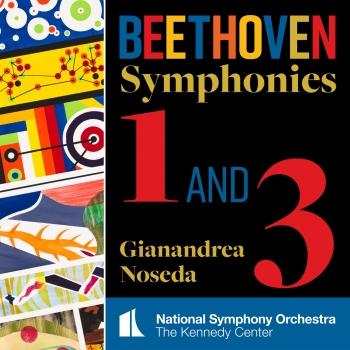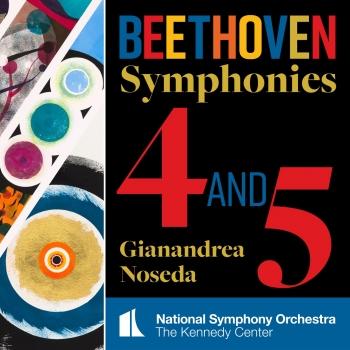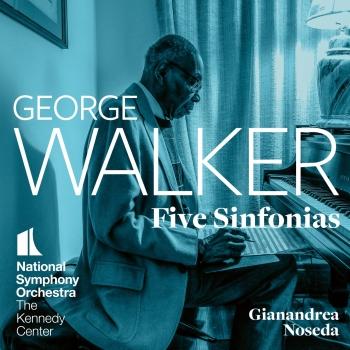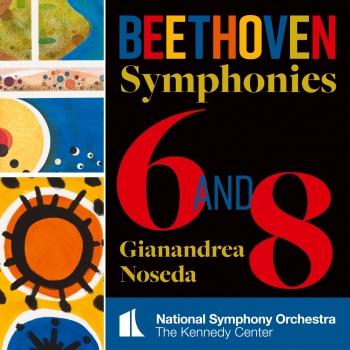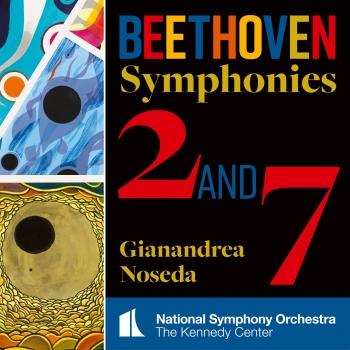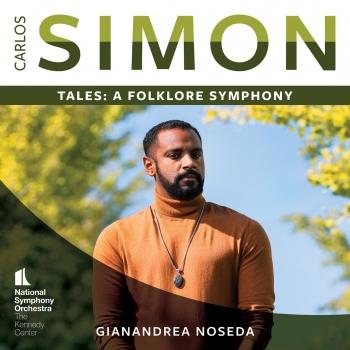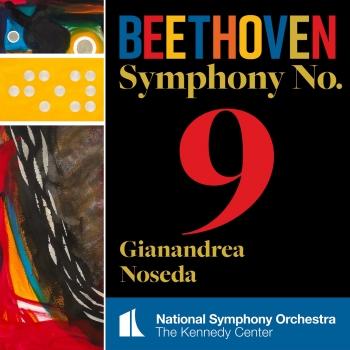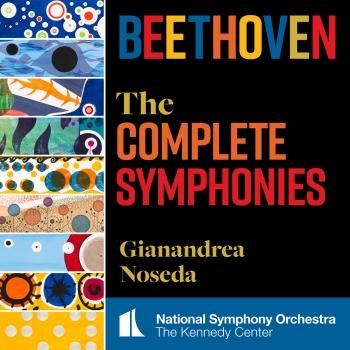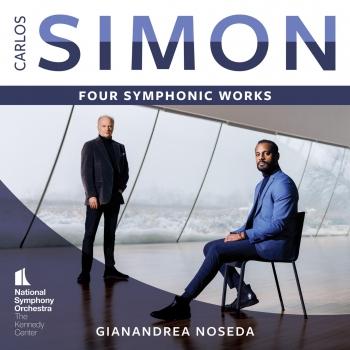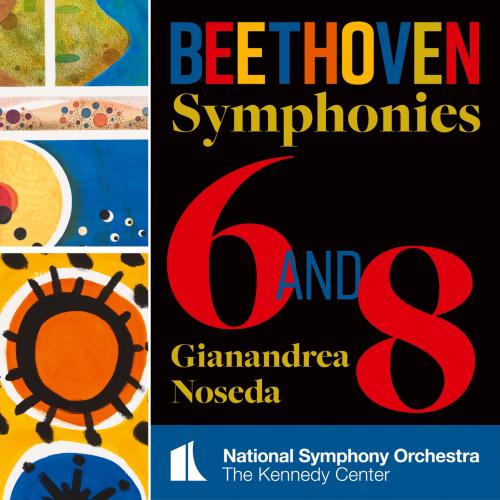
Beethoven: Symphonies Nos 6 & 8 National Symphony Orchestra, Kennedy Center & Gianandrea Noseda
Album info
Album-Release:
2023
HRA-Release:
20.10.2023
Label: National Symphony Orchestra
Genre: Classical
Subgenre: Orchestral
Artist: National Symphony Orchestra, Kennedy Center & Gianandrea Noseda
Composer: Ludwig van Beethoven (1770–1827)
Album including Album cover
- Ludwig van Beethoven (1770 - 1827): Symphony No. 6 in F Major, Op. 68, "Pastoral":
- 1 Beethoven: Symphony No. 6 in F Major, Op. 68, "Pastoral": I. Erwachen heiterer Empfindungen bei der Ankunft auf dem Lande. Allegro ma non troppo 11:15
- 2 Beethoven: Symphony No. 6 in F Major, Op. 68, "Pastoral": II. Szene am Bach. Andante molto moto 11:37
- 3 Beethoven: Symphony No. 6 in F Major, Op. 68, "Pastoral": III. Lustiges Zusammensein der Landleute. Allegro 04:37
- 4 Beethoven: Symphony No. 6 in F Major, Op. 68, "Pastoral": IV. Gewitter. Sturm. Allegro 03:29
- 5 Beethoven: Symphony No. 6 in F Major, Op. 68, "Pastoral": V. Hirtengesang. Frohe und dankbare Gefühle nach dem Sturm. Allegretto 09:43
- Symphony No. 8 in F Major, Op. 93:
- 6 Beethoven: Symphony No. 8 in F Major, Op. 93: I. Allegro vivace e con brio 09:11
- 7 Beethoven: Symphony No. 8 in F Major, Op. 93: II. Allegretto scherzando 04:07
- 8 Beethoven: Symphony No. 8 in F Major, Op. 93: III. Tempo di Menuetto 04:48
- 9 Beethoven: Symphony No. 8 in F Major, Op. 93: IV. Allegro vivace 07:33
Info for Beethoven: Symphonies Nos 6 & 8
The National Symphony Orchestra looks forward to releasing Beethoven’s remaining symphonies over the course of 2023 and 2024. The cover designs for this cycle feature the work of Kennedy Center Education Artist-in-Residence Mo Willems. Inspired by the genius of Ludwig van Beethoven, Willems created a series of large-scale abstractions influenced by each of the composer’s nine symphonies.
Symphony No. 6 in F major, Op. 68, “Pastoral” (1808):
Many musicians and writers on music in the 18th century were preoccupied with music’s expressive and representative powers. Time and again, composers attempted to demonstrate that music was able, even without the help of words, to depict specific feelings and emotions, and even to narrate a sequence of events. One Justin Heinrich Knecht advertised his 1784 symphony, Musical Portrait of Nature, in a music journal on the very same page on which the notice for the 14-year-old Beethoven’s first published works (three piano sonatas) appeared. Knecht’s program, with its shepherds, streams, birds, thunderstorm, and clearing of the sky, is so similar to what Beethoven would have in his “Pastoral” that it is almost certain Beethoven knew Knecht’s work. Beethoven not only loved nature but, as many of his friends attested, worshipped it. Haydn and Mozart were not known for roaming the Austrian countryside; Beethoven, for his part, spent long and happy hours in the woods. He often retreated from Vienna to outlying areas where he admired Nature with a capital N as a true spiritual child of Jean-Jacques Rousseau
and the German Sturm und Drang (“storm and stress”) movement. ...
Symphony No. 8 in F major, Op. 93 (1812):
At first sight, one might think that Beethoven took a step back after completing his fiery and, at the time, super-modern Seventh Symphony, and wrote a companion piece in the style of his elders, Haydn and Mozart. That is, at least, the impression one gets from reading many earlier commentaries. Yet, it is clear that there is not a single measure in this piece that could have been written 20 years earlier, even by Beethoven. One should not be misled by the relative brevity of the Eighth, or by the fact that it contains a minuet, an older type of middle movement than the scherzo Beethoven had been more recently cultivating. In almost every respect—the variety of the harmonies, the richness of the orchestration, the individuality of the formal design—the symphony is anything but backward-looking. Beethoven did seem to revisit the world of his late teacher Joseph Haydn, but he did so without giving up the stylistic accomplishments of his mature years. The result was a real tour de force that Beethoven was justifiably proud of: he told his student Carl Czerny that he considered the Eighth Symphony a “better” work than the Seventh. ...
“Beethoven’s symphonies have moved millions of people. One evening, at a concert almost 250 years after his birth, Beethoven’s work moved me to paint them. The idea of creating art specifically to view while listening to Beethoven’s symphonies, compelled me to spend a year researching, listening, and painting. The result is nine abstractions, a visual art piece for each symphony, rendered in panels, whose sizes represent the lengths of each movement. Through this project, I got to know Beethoven in a new way. When you listen to a symphony you are invited to a dialogue with its creator. I had the opportunity to see his technique change over his career and to feel the journey of his musical notes. I hope these abstractions will spark something in you, as a listener and a viewer. Maybe you’ll even respond to Beethoven with your own art!” (Mo Willems)
National Symphony Orchestra
Gianandrea Noseda, conductor
Gianandrea Noseda
is one of the world’s most sought-after conductors, equally recognized for his artistry in both the concert hall and opera house. The 2021 – 2022 season marks his fifth as Music Director of the National Symphony Orchestra.
Noseda’s artistic leadership has inspired the NSO and in 2019, he and the National Symphony Orchestra earned rave reviews for their first concerts together at New York’s Carnegie Hall and Lincoln Center. The 2019–2020 season saw their artistic partnership continue to flourish with the launch of a new NSO recording label distributed by LSO Live for which Noseda also records as principal guest conductor of the London Symphony Orchestra. The first recording on the label featured Dvořák’s Symphony No 9 and Copland’s Billy the Kid.
Noseda became General Music Director of the Zurich Opera House in September 2021 and will lead multiple productions each season. The centerpiece of his tenure will be a new production of the Ring Cycle, marking his first performances of Wagner’s tetralogy. From 2007 to 2018, Noseda served as Music Director of the Teatro Regio Torino, where his leadership and his initiatives propelled the company’s global reputation resulting in a golden era for this opera house.
National Symphony Orchestra
Founded in Washington, D.C. in 1931 by Hans Kindler, the National Symphony Orchestra (NSO) has always been committed to artistic excellence and music education. Now, nearly 90 years later, the NSO continues to thrive in this capital city. In 1986, the Orchestra became an artistic affiliate of the John F. Kennedy Center for the Performing Arts, where it has performed a full season of subscription concerts since the Center opened in 1971. In addition, the 98-member NSO regularly participates in events of national and international importance, including official holiday celebrations for Memorial and Independence Days through its regularly televised appearances on PBS on the lawn of the U.S. Capitol for Capital Concerts, live-streamed performances from the Kennedy Center Concert Hall on medici.tv, and local radio broadcasts on Classical WETA 90.9FM, making the NSO one of the most-heard orchestras in the country.
Gianandrea Noseda serves as the National Symphony Orchestra’s seventh music director, joining the NSO’s legacy of such distinguished leaders as Christoph Eschenbach, Leonard Slatkin, Mstislav Rostropovich, Antal Doráti, Howard Mitchell, and Hans Kindler. Its artistic leadership also includes Principal Pops Conductor Steven Reineke and Artistic Advisor Ben Folds.
Since assuming the leadership of the NSO, Gianandrea Noseda has brought a renewed sense of energy and focus to the orchestra, which has resulted in wide-ranging recognition from local, national, and international publications, increases in subscription and single ticket sales, and the expansion of the Orchestra’s reach through livestreamed concerts and recordings. The New York Times called the NSO and Noseda’s recent Carnegie Hall appearance 'spectacular', while the Washington Post wrote that 'there’s a certain flair going on at the National Symphony Orchestra', consistently reinforcing that this artistic partnership continues to gain momentum.
Additionally, the NSO’s community engagement projects are nationally recognized, including NSO In Your Neighborhood, which annually comprises a week of performances in schools, churches, community centers, and other unexpected venues; Notes of Honor, which offers free performances for active, veteran, prior service, and retired members of the military and their families; and Sound Health, a collaboration with the National Institutes of Health (NIH) and its affiliated organizations. Career development opportunities for young musicians include the NSO Youth Fellowship Program and its acclaimed, tuition-free Summer Music Institute.
This album contains no booklet.










